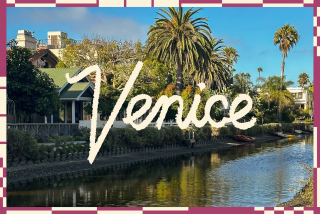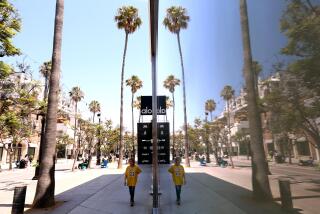New Coalition Determined to ‘Turn Venice Around’
Michael L. Dieden is no stranger to tough causes. In 1982 he campaigned for a dark horse named Tom Hayden, who went on to the state Assembly. Later, he worked for an unsuccessful Latino candidate for the Los Angeles City Council. Now he finds himself campaigning for another dark horse, the community of Venice.
Dieden is the founder and president of the Venice Action Committee, a new coalition of about 50 influential developers, businessmen, artists and residents who are seeking to revitalize the Bohemian beach community through restoration, beautification and modest development projects.
Venice has been resistant to change in the past. But the 36-year-old Dieden, who runs a consulting firm on Ocean Front Walk, contends that his organization has the political muscle and expertise to accomplish its goals.
“These are people who think Venice is turning around,” Dieden said. “They have a big stake in the area . . . and they are committed to seeing Venice become the greatest beach community in the United States.”
The leaders of the Venice Action Committee include producer Tony Bill, who owns the 72 Market restaurant; Tom Sewell, a Venice historian; Phil Bubar, president of the Venice Chamber of Commerce and developers Harlan Lee and Thomas Safran, who both have beachfront condominium projects under way.
Lee, a major Venice property owner and Westside developer, said a lot of talented people “sat back and turned the other cheek” in the past. Now, he said, the Venice Action Committee may be able to generate more interest in the historic community.
“For some reason, the city or the people haven’t taken care of Venice,” Lee said. “But this is an incredible place, and it deserves a lot better. There is a lot of energy here, and I think we can get things done.”
“It’s really exciting,” added Bubar. “(The committee is) fulfilling a need in the community . . . and any action that’s positive is worthwhile.”
The committee’s first project since being formed last month was distributing free fruit trees. Its next goal is to paint the Venice City Hall, which will cost about $10,000. In the future, Dieden said the group will undertake more ambitious projects.
He said the organization will encourage “reasonable” growth along the beachfront and elsewhere. Like the Chamber of Commerce and the Venice Town Council, it will participate in government hearings on planning for the area’s future.
The leaders of the Venice Action Committee have yet to disclose specific development proposals. Lee said the group may seek out the advice of planning experts in the academic field. Dieden added that the organization will probably clash occasionally with the Venice Town Council, a community group that favors extremely limited growth.
“The difference between the people on the Venice Action Committee and those with other groups is that we view development as a positive thing,” Dieden said. “But I hope there will be cooperation among the groups.”
Patrick McCartney, the president of the town council, said he hopes the two groups can peacefully coexist. He said the organizations share many concerns, but added that they probably disagree on the major growth questions.
“They want to prettify Venice and make it nice for all the young professionals who have moved here,” McCartney said. “While that’s laudable, Venice is composed of a much larger community. . . . It remains to be seen how many of their projects will be sensitive to the entire community.”
Group Needs Time
Los Angeles City Councilwoman Pat Russell, who represents the Venice area, said she was pleased by the formation of the Venice Action Committee. But she added that the group needs time to “produce a track record.”
“I was really impressed with their upbeat feeling and their desire to do positive things,” said Russell, who attended a meeting.
Dieden said Venice is already on the move. On a recent early morning run, when the vagrants were still sleeping and the vendors had yet to appear, he was quick to point out the signs of change along the beach.
A fence surrounded the spot where developer Safran’s condominium-retail project will stand. Trucks were parked in front of a cluster of cottages that are being turned into a bed-and-breakfast inn. Lee is planning a development on an empty lot on Venice’s northern border.
“There are going to be some changes here in the next 10 years,” Dieden said. “We have a big commitment to this. . . . The chemistry is right.”
More to Read
Sign up for Essential California
The most important California stories and recommendations in your inbox every morning.
You may occasionally receive promotional content from the Los Angeles Times.










